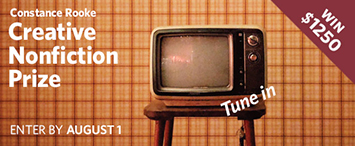CNF Prize contest open!

Submit your personal essays, memoirs, travel writing, biographies, and more. This year, we've increased the prize amount (CAD $1,250) and word limit (4,000 max). Plus, if you enter by June 30, you'll get an Early Bird discount of $15 off your initial entry fee!
This year's judge:
D. A. Lockhart
Early Bird discount entry fee until June 30, 2022 (includes a one-year print subscription):
$20 CAD for each entry from Canada
$30 CAD for each entry from elsewhere
$15 CAD for each additional entry, no limit!
Full contest guidelines on our website.
Joan Rivard, spring issue #218 poetry contributor
 Past Editorial Assistant Amanda Proctor talks with the spring issue #218 poetry contributor about mental health, language as more than rules, and creating a respectful authenticity in her two poems, “[amˈbigyoōəs] [lôs, läs]” and “Prophet.” Past Editorial Assistant Amanda Proctor talks with the spring issue #218 poetry contributor about mental health, language as more than rules, and creating a respectful authenticity in her two poems, “[amˈbigyoōəs] [lôs, läs]” and “Prophet.”
AP: In “[amˈbigyoōəs] [lôs, läs],” the International Phonetic Alphabet is woven throughout. What informed the choice of bringing the IPA into the poem, and what was that process like?
JR :
This poem speaks of the period during which my mother developed Alzheimer’s disease and my daughter developed schizophrenia. Their illnesses, and my own fear, badly affected our ability to communicate. My mother lost track of who I was, so our talks became increasingly strained. Talks with my daughter began to hopelessly tangle in my anxiety and her delusions. I tried to find better ways to communicate. This was a difficult period for all concerned, and my heart goes out to anyone else walking through it. I was ably propped up by support groups and I recommend this if possible.
The poem uses International Phonetic Alphabet (IPA) to symbolize the speaker’s search for aids to help her communicate with her “beloved ladies.” In the first draft, I just placed the IPA “translations” where I thought the repetition would emphasize certain key concepts, especially when spoken aloud. In the second draft I gave the poem an acrostic structure, again representing the search for alternate methods of communication. By the final draft, I forced the reader to learn IPA by increasing its use as the poem progresses. In effect, the reader, too, must leave their language. In the last stanza I removed the comfort of conventional spelling, and the reader is left alone to decide the meaning of the last word, “(sôrō).”
Read the rest of Joan Rivard's interview as well as an excerpt.
|
|
|
|
|
|
|
|